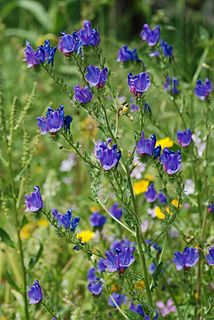
Echium plantagineum, commonly known as purple viper's-bugloss or Patterson's curse, is a species of the genus Echium native to western and southern Europe, northern Africa, and southwestern Asia. It has also been introduced to Australia, South Africa and United States, where it is an invasive weed. Due to a high concentration of pyrrolizidine alkaloids, it is poisonous to grazing livestock, especially those with very simple digestive systems, like horses.
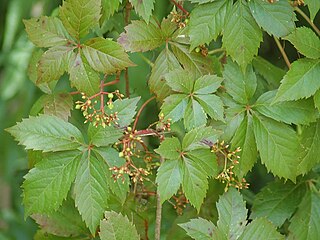
Parthenocissus quinquefolia, known as Virginia creeper, Victoria creeper, five-leaved ivy, or five-finger, is a species of flowering vine in the grape family, Vitaceae. It is native to eastern and central North America, from southeastern Canada and the eastern United States west to Manitoba and Utah, and south to eastern Mexico and Guatemala.

Spathiphyllum floribundum, the snowflower, peace lily, is a flowering plant in the family Araceae, native to northwestern South America from Panama east to Venezuela and south to Peru.

Myoporum is a genus of flowering plants in the figwort family, Scrophulariaceae. There are 30 species in the genus, eighteen of which are endemic to Australia although others are endemic to Pacific Islands, including New Zealand, and one is endemic to two Indian Ocean islands. They are shrubs or small trees with leaves that are arranged alternately and have white, occasionally pink flowers and a fruit that is a drupe.

Rodondo Island is a granite island, part of the Rodondo Group, lying in northern Bass Strait, within the state boundaries of Tasmania, Australia. The island is located only 10 kilometres (6.2 mi) south of Wilsons Promontory in Victoria, and 2' of latitude south of the Victoria-Tasmania border at latitude 39°12'S. Rodondo Island is ringed by steep cliffs up to 200 metres (660 ft) high, with an area of 106 hectares and a maximum elevation of 350 metres (1,150 ft) above sea level.

Tropaeolum majus, the garden nasturtium, nasturtium, Indian cress or monks cress, is a species of flowering plant in the family Tropaeolaceae, originating in the Andes from Bolivia north to Colombia. An easily-grown annual or short-lived perennial with disc-shaped leaves and brilliant yellow, orange or red flowers, it is of cultivated, probably hybrid origin. It is not closely related to the genus Nasturtium.

Eucalyptus leucoxylon, commonly known as yellow gum, blue gum or white ironbark, is a species of small to medium-sized tree that is endemic to south-eastern continental Australia. It has smooth yellowish bark with some rough bark near the base, lance-shaped or curved adult leaves, flower buds in groups of three and cylindrical, barrel-shaped or shortened spherical fruit. A widely cultivated species, it has white, red or pink flowers.

Grevillea lavandulacea, commonly known as lavender grevillea, is a species of flowering plant in the family Proteaceae and is endemic to southern continental Australia. It is a prostrate to spreading shrub with linear to elliptic leaves and clusters of pink to red flowers.

Senecio tamoides, also known as Canary creeper, is a climbing member of the genus Senecio of the family Asteraceae that is native to Southern Africa. It is used as an ornamental plant for its showy yellow, daisy-like flowers in autumn.

Causonis japonica is the type species of vine plant in its genus and is native to Tropical and Subtropical Asia, Australia and the West Pacific. It is used as a traditional Chinese medicine to relieve swelling and heat, and to enhance diuresis and detoxification.

Syzygium floribundum, synonym Waterhousea floribunda, is a rainforest tree of eastern Australia. It grows along streams from the Williams River near Dungog to Mackay in central eastern Queensland. Known as the weeping lilli pilli, this tree is widely planted as an ornamental. Planted trees from 1827 may be seen at the Royal Botanic Gardens, Sydney. However, these trees are damaged and threatened by the roosting grey headed flying foxes. A very large tree is located at Western Park in Auckland, New Zealand.

Melaleuca squarrosa, commonly known as scented paperbark, is a plant in the myrtle family, Myrtaceae and is endemic to south eastern parts of Australia, especially Tasmania. It is an attractive shrub with dense foliage and arching branches and it flowers profusely in spring or early summer, bearing spikes of perfumed yellow to white flowers.

Lasiopetalum floribundum, commonly known as free flowering lasiopetalum, is a species of flowering plant in the family Malvaceae and is endemic to the south-west of Western Australia. It is an erect or spreading shrub with hairy young stems, egg-shaped leaves and pale pink, mauve or white flowers.
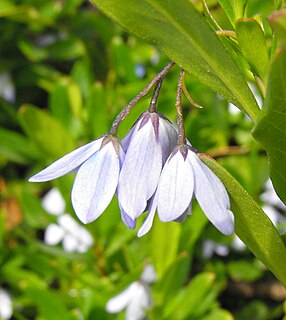
Billardiera heterophylla is a species of flowering plant in the family Pittosporaceae, known by the common name bluebell creeper. It is native to Western Australia, but is grown as an ornamental plant in appropriate climates worldwide. It can sometimes be found growing in the wild as an introduced species or garden escapee, for example in other Australian states and in California, where it is popular in landscaping. It is sometimes considered a weed.

Comesperma volubile, commonly known as love creeper, is a slender climber in the family Polygalaceae. It grows to between 1 and 2 metres high. The leaves are 10 to 50 mm long and 1 to 5 mm wide. Blue or pale purple flowers are produced in sprays from July to December in the species' native range. It occurs in heathland and forest in the states of Western Australia, South Australia, Tasmania, Victoria, New South Wales and Queensland in Australia.
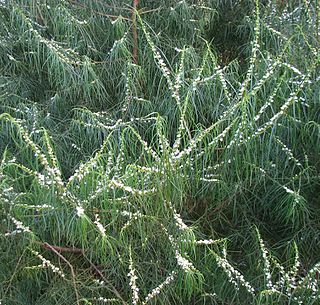
Myoporum floribundum, commonly known as weeping myoporum or slender myoporum, is a sour-smelling glabrous shrub in the family Scrophulariaceae endemic to a small area of New South Wales and Victoria in Australia. It has long, thin, drooping leaves and profuse white flowers in clusters along the stems in spring. Although it is uncommon in nature, it has long been available as a popular garden plant.
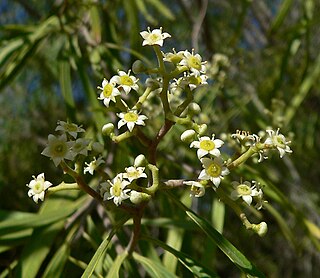
Geijera parviflora, commonly known as wilga, is a species of shrub or small tree in the family Rutaceae and is endemic to inland parts of eastern Australia. It has drooping branches, linear to narrow lance-shaped leaves, small white flowers in loose panicles and spherical fruit containing a shiny black seed. Other vernacular names include Australian willow, native willow, sheepbush and dogwood.
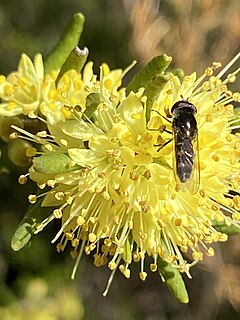
Leionema phylicifolium, commonly known as alpine phebalium, is a shrub that is endemic to south-eastern Australia. It is a small shrub with green, smooth, leathery leaves and pale yellow flowers in spring.

Isotoma fluviatilis, the swamp isotome or blue star creeper, is a small herbaceous perennial plant in the family Campanulaceae, native to Australia.

Kennedia glabrata, commonly known as Northcliffe kennedia, is a species of flowering plant in the family Fabaceae and is endemic to the south-west of Western Australia. It is a prostrate shrub or creeper with trifoliate leaves and orange-pink to red flowers with a yellow centre.




















